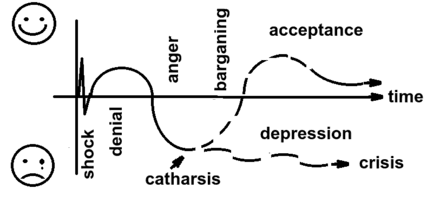“On Death And Dying” Or, The 5 Stages Of Grief
In her classic of 1969, On Death and Dying, the psychiatrist Elisabeth Kübler-Ross introduced a model of bereavement that is commonly referred to as the Five Stages of Grief. This model describes, in five discrete stages, a process by which people react to grief and tragedy, especially terminal illness or catastrophic loss. The five stages are denial, anger, bargaining, depression (or grieving), and acceptance.
31
153 reads
CURATED FROM
The Psychology of Self-Deception - Ego Defence 1 of 10: Denial
psychologytoday.com
8 ideas
·1.21K reads
IDEAS CURATED BY
We deceive ourselves to protect ourselves, but the fact remains: we deceive ourselves; and, so, we harm ourselves. We can’t do a lot about it, but maybe we can do a little, if we know what it is that we do. A 10-part series.
“
The idea is part of this collection:
Learn more about psychology with this collection
Techniques for brainstorming and generating new ideas
The power of collaboration and feedback in the creative process
How to recognize and overcome limiting beliefs
Related collections
Similar ideas to “On Death And Dying” Or, The 5 Stages Of Grief
The Kübler-Ross Model of Grieving
Grief comes in many forms and everyone has experienced it in many different ways, but this model theory is only a reference, not a rule. The five stages of grief are:
- Denial
- Anger
- Bargaining
- Depression
- Acceptance.
The Five Stages Of Grief
The stages of coming in terms with grief are:
- Denial
- Anger
- Bargaining
- Depression
- Acceptance
These widely accepted stages are considered rigid and obsolete as modern psychologists update the understanding of grief.
The 5 Stages of Grief model.
One example of such integration is the 5 Stages of Grief model. While it might be not a universal one, it turns out that these stages map beautifully into fear responses:
- Denial → flight
- Anger → fight
- Barg...
Read & Learn
20x Faster
without
deepstash
with
deepstash
with
deepstash
Personalized microlearning
—
100+ Learning Journeys
—
Access to 200,000+ ideas
—
Access to the mobile app
—
Unlimited idea saving
—
—
Unlimited history
—
—
Unlimited listening to ideas
—
—
Downloading & offline access
—
—
Supercharge your mind with one idea per day
Enter your email and spend 1 minute every day to learn something new.
I agree to receive email updates

